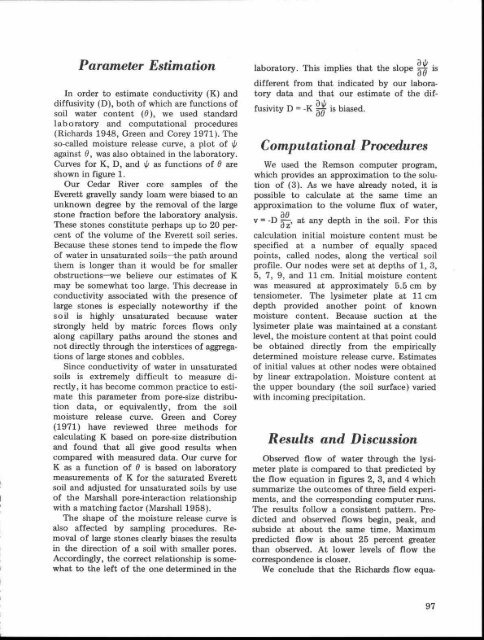PE EIE[R-Rg RESEARCH ON - HJ Andrews Experimental Forest
PE EIE[R-Rg RESEARCH ON - HJ Andrews Experimental Forest
PE EIE[R-Rg RESEARCH ON - HJ Andrews Experimental Forest
Create successful ePaper yourself
Turn your PDF publications into a flip-book with our unique Google optimized e-Paper software.
Parameter Estimation<br />
In order to estimate conductivity (K) and<br />
diffusivity (D), both of which are functions of<br />
soil water content (0), we used standar d<br />
laboratory and computational procedures<br />
(Richards 1948, Green and Corey 1971) . The<br />
so-called moisture release curve, a plot of ,1i<br />
against 0, was also obtained in the laboratory .<br />
Curves for K, D, and as functions of 0 are<br />
shown in figure 1 .<br />
Our Cedar River core samples of the<br />
Everett gravelly sandy loam were biased to an<br />
unknown degree by the removal of the large<br />
stone fraction before the laboratory analysis .<br />
These stones constitute perhaps up to 20 per -<br />
cent of the volume of the Everett soil series .<br />
Because these stones tend to impede the flo w<br />
of water in unsaturated soils-the path aroun d<br />
them is longer than it would be for smaller<br />
obstructions-we believe our estimates of K<br />
may be somewhat too large . This decrease in<br />
conductivity associated with the presence o f<br />
large stones is especially noteworthy if th e<br />
soil is highly unsaturated because water<br />
strongly held by matric forces flows only<br />
along capillary paths around the stones an d<br />
not directly through the interstices of aggregations<br />
of large stones and cobbles .<br />
Since conductivity of water in unsaturate d<br />
soils is extremely difficult to measure directly,<br />
it has become common practice to estimate<br />
this parameter from pore-size distribution<br />
data, or equivalently, from the soil<br />
moisture release curve. Green and Corey<br />
(1971) have reviewed three methods fo r<br />
calculating K based on pore-size distribution<br />
and found that all give good results whe n<br />
compared with measured data . Our curve for<br />
K as a function of 0 is based on laboratory<br />
measurements of K for the saturated Everett<br />
soil and adjusted for unsaturated soils by us e<br />
of the Marshall pore-interaction relationship<br />
with a matching factor (Marshall 1958) .<br />
The shape of the moisture release curve i s<br />
also affected by sampling procedures. Removal<br />
of large stones clearly biases the result s<br />
in the direction of a soil with smaller pores .<br />
Accordingly, the correct relationship is some -<br />
what to the left of the one determined in the<br />
laboratory . This implies that the slope aO i s<br />
different from that indicated by our laboratory<br />
data and that our estimate of the dif -<br />
fusivity D = -K is biased .<br />
ao<br />
Computational Procedures<br />
We used the Remson computer program ,<br />
which provides an approximation to the solution<br />
of (3). As we have already noted, it is<br />
possible to calculate at the same time a n<br />
approximation to the volume flux of water ,<br />
v = -D ae, at any depth in the soil. For thi s<br />
calculation initial moisture content must b e<br />
specified at a number of equally space d<br />
points, called nodes, along the vertical soil<br />
profile. Our nodes were set at depths of 1, 3 ,<br />
5, 7, 9, and 11 cm. Initial moisture content<br />
was measured at approximately 5 .5 cm by<br />
tensiometer. The lysimeter plate at 11 cm<br />
depth provided another point of known<br />
moisture content . Because suction at the<br />
lysimeter plate was maintained at a constant<br />
level, the moisture content at that point coul d<br />
be obtained directly from the empirically<br />
determined moisture release curve. Estimate s<br />
of initial values at other nodes were obtaine d<br />
by linear extrapolation . Moisture content at<br />
the upper boundary (the soil surface) varie d<br />
with incoming precipitation .<br />
Results and Discussion<br />
Observed flow of water through the lysimeter<br />
plate is compared to that predicted by<br />
the flow equation in figures 2, 3, and 4 which<br />
summarize the outcomes of three field experiments,<br />
and the corresponding computer runs .<br />
The results follow a consistent pattern . Predicted<br />
and observed flows begin, peak, an d<br />
subside at about the same time . Maximu m<br />
predicted flow is about 25 percent greate r<br />
than observed. At lower levels of flow th e<br />
correspondence is closer .<br />
We conclude that the Richards flow equa -<br />
97








